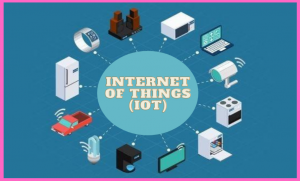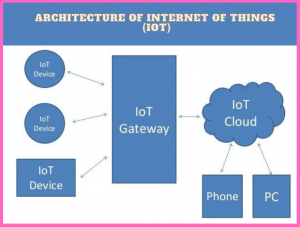Internet of things
What is the Internet of Things (IoT)?
Internet of Things known as (IoT) relates to the ever-rising network of physical devices with an IP address of internet access, and the connection among such devices and other internet-connected devices or systems. The IoT, relates to the millions of hardware devices globally which are now networked, all of which collect and transfer data. With the introduction of super-cheap microchips and the omnipotence of wireless networks, anything can be turned into a component of the IoT, from something as tiny as a pill to something as large as a jet.

Figure. 1 A little description about the Internet of Things
The importance of the internet of things.
The internet of things enables users to work in a better way and to gain full control of their activities. IoT is crucial for the industry, in contrast to enabling smart devices to optimize houses. IoT gives companies a real-time view about how their functionalities and how these actually operate, providing visibility through anything from computer capability to supplier chain and logistics processes. IoT helps enterprises to make their operations simple and reduce the labour costs. This also makes a reduction in waste and boosts service quality, securing it a little less expensive to generate and supply products, and also gripping customer transactions open. It is modern technology.
The architecture of the Internet of Things (IoT).
Since IoT offers exciting opportunities, more companies are looking to use their services in their business operations. However, this innovative idea seems too difficult to be applied when it comes to practice — considering the range of tools and requirements required to make it work. In other terms, the topic of creating a stable Internet of Things infrastructure inevitably gets on the stage. IoT is not just a consumer device linked to the web. Nevertheless, IoT is the system that offers devices capable of independently responding appropriately to real-world signals without human involvement. Then we need to create a flow diagram for a specific foundation on which to construct an IoT solution. Usually, IoT Architecture consists of these four stages:
Below are the four layers listed in details for the IoT architecture:

Figure.2 Architecture of Internet of things (IoT)
Things, sensors, and controllers.
The IoT layer incorporates machines, sensors, and controllers. These products involve devices like mobile phones or laptops, single-board computers and microcontroller systems. The linked devices represent the true endpoint for IoT. Specific sensors detect variations in their surroundings and turn analysed data into a digital medium for processing by the external microcontroller. The integration of the microprocessors in a single system allows the sensors to become “smart.” Technology has allowed this arrangement to be achieved inside small packaging. Control systems and gateways are middle-tier elements which gather information predominantly from front-end devices. Moreover, there are broad variations in the function of controllers (consumer-focused) and gateways (commercial focus) in accessing this data. In certain situations, a gateway may concentrate mainly on data collecting, data processing and then the data transfer to a back-end network. The duration correlated with the compilation, storage and delivery of this data can differ from streaming and queuing in real-time to bulk processing.
Gateways and data acquisition.
Each IoT system requires a way to link sensors/devices to the cloud so that information among them could be sent backwards and forwards. IoT gateways can be necessary to allow this link, as gateways serve as interfaces among sensors/devices and the cloud. Most sensors/devices will “speak” to a gateway and then the gateway will carry all of that data into the cloud and “speak.” It is in reality the manner cellular technology operates at a professional rate too. The handset does not interact directly with the other users, but rather interacts with the nearest cellular tower, that in effect interacts with the databases of the network company ( e.g. AT&T). Data then moves in the reverse way, from the servers of the cellular provider to towers, to somebody else’s devices. The basic principle for IoT implementations is the very same, simply swap out the gateway for the cellular tower and the cloud for the databases of the cellular supplier. This layer also operates in close vicinity to sensors and actuators on provided devices, it is important to define it as a unique entity of IoT network as it is vital for the collection of data, sorting and transmission operations to interface infrastructure and cloud-based networks. Considering the vast amount of input and output that hundred thousand-device deployments will produce, data collection, selection and mobility functionality should be at the centre of attention. Gateways and data acquisition systems just provide a requisite link point that binds the existing layers with each other as mediators between the linked items and the cloud and analytics.
Edge analytics:
Edge analytics is the selection, processing and evaluation of data either at or nearby a sensor, a networking device or some other linked machine at the network edge. With the increase in the sustainability of smart devices as the Internet of Things ( IoT) grows, many businesses such as retail, manufacturing, transportation, and energy produce large quantities of data at the network edge. Edge analytics is real-time and also in-situ data analytics, or at the platform where a collection of data is taking place. Edge analytics may be descriptive, diagnostic, or statistical. The edge analytics approach has become much more realistic with the enhancement of internet and cloud access due to technologies such as 5 G networks. Crucially it has grown due to the use of quick response times and IoT systems implement rapid data analytics. Sensors, digital systems, and other smart devices would not be successful if their whole data collection cycle involved transmitting back and waiting for processing and returning data to a central location.
Data centre / Cloud platform.
Cloud computing is being mainstreamed with rapid progress in 5 G and Internet speed, enabling companies to access remote computing resources with a click of the mouse. Through eliminating the need to manage the on-site framework, the cloud has allowed companies to surpass traditional IoT implementations (e.g. in household appliances) and has opened new gates to large-scale IoT implementation in previously unexplored areas. The Internet of Things depends on IoT frameworks to allow the availability, maintenance and optimization of connected devices within a given IoT network in an attempt to put physical objects online and to allow them to interact, collaborate and evident especially without human interference.